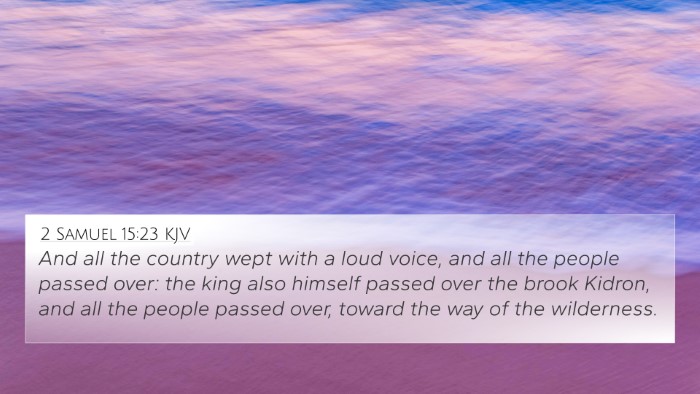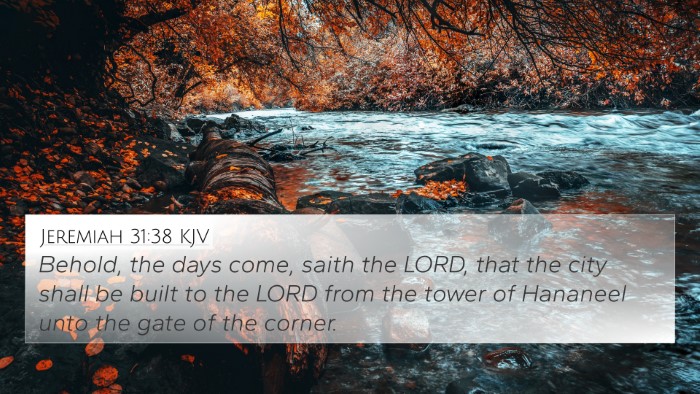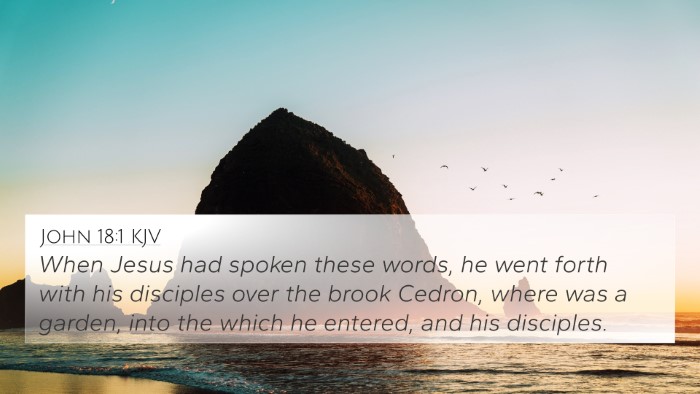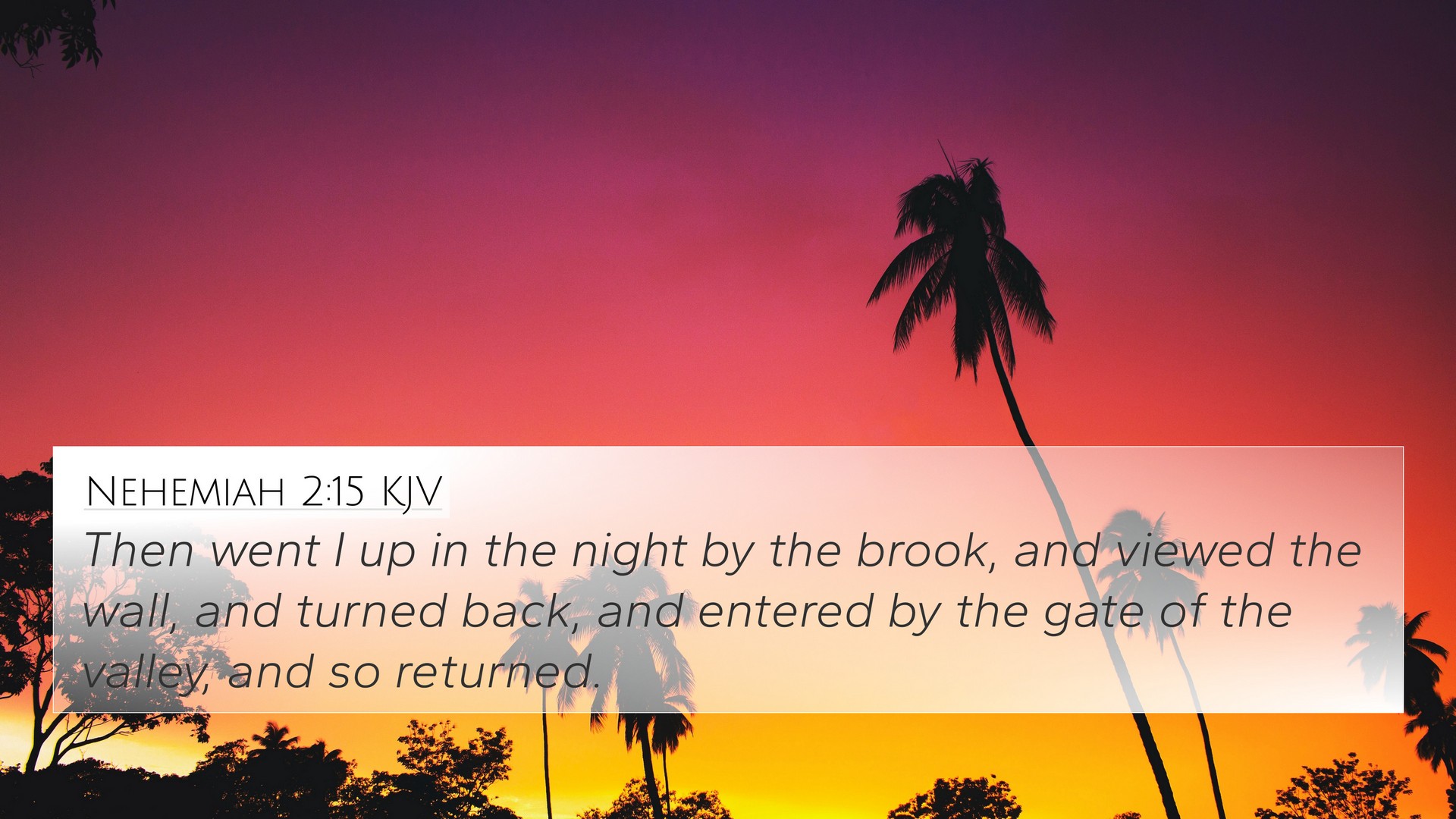Old Testament
Genesis Exodus Leviticus Numbers Deuteronomy Joshua Judges Ruth 1 Samuel 2 Samuel 1 Kings 2 Kings 1 Chronicles 2 Chronicles Ezra Nehemiah Esther Job Psalms Proverbs Ecclesiastes Song of Solomon Isaiah Jeremiah Lamentations Ezekiel Daniel Hosea Joel Amos Obadiah Jonah Micah Nahum Habakkuk Zephaniah Haggai Zechariah MalachiNehemiah 2:15 Similar Verses
Nehemiah 2:15 Cross References
Then went I up in the night by the brook, and viewed the wall, and turned back, and entered by the gate of the valley, and so returned.
Uncover the Rich Themes and Topics of This Bible Verse
Listed below are the Bible themes associated with Nehemiah 2:15. We invite you to explore each theme to gain deeper insights into the Scriptures.
Nehemiah 2:15 Cross Reference Verses
This section features a detailed cross-reference designed to enrich your understanding of the Scriptures. Below, you will find carefully selected verses that echo the themes and teachings related to Nehemiah 2:15 KJV. Click on any image to explore detailed analyses of related Bible verses and uncover deeper theological insights.

2 Samuel 15:23 (KJV) »
And all the country wept with a loud voice, and all the people passed over: the king also himself passed over the brook Kidron, and all the people passed over, toward the way of the wilderness.

Jeremiah 31:38 (KJV) »
Behold, the days come, saith the LORD, that the city shall be built to the LORD from the tower of Hananeel unto the gate of the corner.

John 18:1 (KJV) »
When Jesus had spoken these words, he went forth with his disciples over the brook Cedron, where was a garden, into the which he entered, and his disciples.
Nehemiah 2:15 Verse Analysis and Similar Verses
Understanding Nehemiah 2:15
Nehemiah 2:15 states: "Then went I up in the night by the brook, and viewed the wall of the city, and turned back, and entered by the gate of the valley, and so returned." This verse encapsulates Nehemiah’s careful assessment of Jerusalem’s walls, demonstrating his strategic and prayerful approach to the task at hand.
Summary of Key Insights
Insights from public domain commentaries such as those by Matthew Henry, Albert Barnes, and Adam Clarke reveal critical aspects of Nehemiah’s leadership, historical context, and spiritual application.
1. Nehemiah’s Purposeful Investigation
Nehemiah undertook a nocturnal journey to survey the damage done to Jerusalem’s walls. This action showcases his commitment to understanding the gravity of the situation. Commentators emphasize the importance of thorough preparation before embarking on significant endeavors.
2. Symbolism of the Night
The choice to inspect at night may symbolize introspection and a desire to avoid immediate confrontation or scrutiny. Henry notes that this time of quiet reflection was crucial for Nehemiah to gather his thoughts and strategize without external pressures.
3. The Brook and the Gate
The reference to the brook and the gate highlights Nehemiah’s deliberate route and methodical exploration. Adam Clarke emphasizes that each location holds significance, representing a thorough approach in evaluating the city’s state. The gates of the city are points of entrance and connection, reminding us of the importance of access and openness in leadership.
4. Historical Context and Leadership
Albert Barnes explains the historical backdrop of Nehemiah’s mission to rebuild Jerusalem’s walls following the Babylonian exile. Understanding this context aligns with viewing Nehemiah as a leader with a divine mandate, emphasizing the role of God in guiding his efforts.
5. Spiritual Application
This verse serves as a reminder of the necessity for diligent assessment and prayerful preparation before undertaking endeavors that affect communities. Commentators highlight the spiritual fortitude Nehemiah displayed through his actions, encouraging faith-driven leadership.
Cross References for Nehemiah 2:15
- Nehemiah 1:4-6: Nehemiah’s prayer for Jerusalem, reflecting his deep concern for his people.
- Nehemiah 2:17: Nehemiah calls the people to action, paralleling his thorough assessment with their response.
- Psalm 137:1: A reflection on the desolation of Zion, offering background to Nehemiah’s sorrow and purpose.
- Isaiah 58:12: Encouragement for rebuilding the old waste places, underscoring the theme of restoration.
- Ezra 4:4-5: Understanding the opposition faced in rebuilding emphasizes the need for careful planning.
- Proverbs 21:5: Diligence in planning leads to profit, resonating with Nehemiah’s meticulous approach.
- Jeremiah 30:18: Prophetic reassurance of restoration, connecting with Nehemiah’s mission.
- Luke 14:28: The importance of counting the cost before starting a construction project, akin to Nehemiah’s survey.
- 1 Corinthians 3:10: Paul speaks about laying a foundation wisely, similar to Nehemiah’s groundwork for rebuilding.
- Hebrews 11:30: By faith, the walls of Jericho fell, paralleling the dependence on God for successful reconstruction.
Thematic Connections
Nehemiah 2:15 serves not only as a historical account but also as a theological reflection on God’s providential care for His people and their endeavors. The themes of restoration, leadership, and faith run through this verse, linking it to various passages throughout Scripture.
How This Connects with Other Scriptures
By examining Nehemiah in the light of other biblical texts, we can see how his actions were not isolated but part of a larger narrative of God's work through His people. This reinforces the concept of Bible verse cross-references and the connections between Bible verses throughout Scripture.
Tools for Further Exploration
To delve deeper into the cross-referencing of Biblical texts, scholars and students can utilize several tools such as:
- Bible concordance: A tool that lists words found in the Bible, alongside their various occurrences.
- Bible cross-reference guide: Resources that link related verses for thematic study.
- Cross-reference Bible study: Methods to explore interconnections for deeper understanding.
- Bible reference resources: Materials available for detailed study of scripture.
- Bible chain references: Systems that connect verses in a sequential manner for thematic exploration.
Conclusion
Nehemiah 2:15 provides profound insights into the principles of leadership, prayer, and community restoration. This verse resonates with themes that echo throughout the scriptures, inviting readers to reflect on their spiritual journeys and the interconnectedness of biblical teachings.


